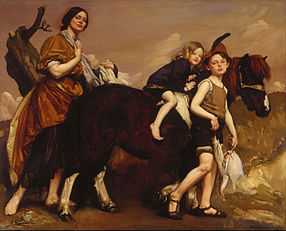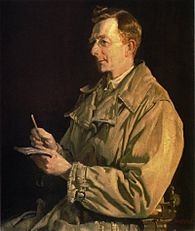
George Washington Lambert

George Washington Lambert | |
|---|---|
 George Washington Lambert, c.1925, by Harold Cazneaux | |
| Born | George Washington Lambert 13 September 1873 Saint Petersburg, Russian Empire |
| Died | 29 May 1930 (aged 56) |
| Nationality | Australian |
| Education | Julian Ashton Art School |
| Known for | Painting, drawing, sculpture |
| Notable work | Across the Black Soil Plains (1899) Anzac, the Landing 1915 (1922) The Squatter's Daughter (1924) Mrs Annie Murdoch (1927) |
| Children | Maurice Lambert, Constant Lambert |
George Washington Thomas Lambert ARA (13 September 1873 – 29 May 1930) was an Australian artist, known principally for portrait painting and as a war artist during the First World War.

Early life
Lambert was born in St Petersburg, Russia, the posthumous son of George Washington Lambert (1833 – 25 July 1873, in London) of Baltimore, Maryland. The younger Lambert's mother was Annie Matilda, née Firth, an Englishwoman. Mother and son soon moved to Württemberg, Germany, to be with Lambert's maternal grandfather. Lambert was educated at Kingston College, Yeovil, Somerset. The family, consisting of Lambert, his mother and three sisters, decided to emigrate to Australia. They arrived in Sydney aboard the Bengal on 20 January 1887.[1]

Career

Lambert began exhibiting his pictures at the Art Society and the Society of Artists, Sydney in 1894. Lambert began contributing pen-and-ink cartoons for The Bulletin in 1895 and began painting full-time in 1896.[1] Illustrations by Lambert formed part of the bush ballads of the Fair girls and gray horses (1898) and Hearts of gold (1903) anthologies of Scottish-Australian poet Will H. Ogilvie (1869–1963).

In 1899 he won the Wynne Prize with Across the Blacksoil Plains. He studied at the Julian Ashton Art School in Sydney until 1900. Later, he won a travelling scholarship for 150 pounds from the government of New South Wales. He spent a year in Paris before moving to London where he exhibited at the Royal Academy. Lambert was awarded a silver medal at an international exhibition for his painting The Sonnet in Barcelona in 1911. He was most known during this time as a portrait artist.

War artist

Lambert became an official Australian war artist in 1917 during the First World War.[2] His painting Anzac, the landing 1915 of the landings on the Gallipoli peninsula in Turkey, is the largest painting at the Australian War Memorial collection. Lambert, as an honorary captain, travelled to Gallipoli in 1919 to make sketches for the painting.[1] Another noted work was A sergeant of the Light Horse (1920), painted in London after his travels in Palestine.[3]

During the war years, George Lambert spent much time in London, where it is suggested he was romantically involved with fellow artist Thea Proctor.

Return to Australia
Lambert returned to Australia in 1921, where he had success in Melbourne with a one-man show at Fine Art Society gallery. He was elected an associate of the Royal Academy in 1922. He often visited the homestead of Colonel Granville Ryrie of the Australian Light Horse at Michelago, New South Wales and there painted The Squatter's Daughter and Michelago Landscape.

In the second annual Archibald Prize in 1922, now Australia's most prestigious art prize for portraiture, Lambert's work was disqualified as he had not been a resident in Australia for twelve months.[4] He submitted a self-portrait for the third year, competing with William Macleod who entered with the subject of The Bulletin cartoonist 'Hop' Hopkins.[5] In 1927 he won the Archibald Prize with Mrs Annie Murdoch, a portrait of the mother of Keith Murdoch and grandmother of Rupert Murdoch.

In November 1927 he was commissioned to create a statue of writer Henry Lawson; the work depicting Lawson in rough clothes accompanied by a swagman, a dog and a fence post was unveiled in The Domain, Sydney on 28 July 1931 by the Governor of New South Wales, Sir Philip Game.[6]

Personal life
Lambert married Amelia Beatrice 'Amy' Absell (1872–1963) in 1900. Their children were Maurice Lambert (1901–1964), a noted sculptor and associate of the Royal Academy, and Constant, the British composer and conductor, born in London in 1905. Kit Lambert (1935–1981), manager of the rock group The Who, was their grandchild.

Lambert died on 29 May 1930 at Cobbitty, near Camden, New South Wales, and is buried in the Anglican section of South Head Cemetery.[1]

Some of his family papers from 1874 to 1942 are held in the State Library of New South Wales, Sydney.[7]

His life was dramatised in an episode of the radio series Famous Australians.

Gallery
-
Portrait of the Artist's Family
-
Holiday in Essex
-
Portrait of a Lady
-
The Holiday Group (The Bathers)
-
Sybil Waller in a Red and Gold Dress
-
Miss Thea Proctor
-
The artist's wife, Amy, and their son Constant
See also
Notes
- ^ a b c d Martin Terry (1983). "Lambert, George Washington (1873–1930)". Lambert, George Washington Thomas (1873 - 1930). Australian Dictionary of Biography, Volume 9. MUP. pp. 649–650. Retrieved 15 July 2009.
- ^ 'Camofleur', "Musketeers of Brush and Pencil with the A.I.F.: Art Under Fire: The Battlefield as Studio", The (Melbourne) Herald, (1 February 1919), p. 4.
- ^ "A sergeant of the Light Horse". George W Lambert Retrospective. National Gallery of Australia. Retrieved 4 May 2013.
- ^ "Archibald Prize". The Daily Telegraph. No. 13, 621. New South Wales, Australia. 6 January 1923. p. 5. Retrieved 24 February 2019 – via National Library of Australia.
- ^ "Gossip". Smith's Weekly. Vol. IV, no. 46. New South Wales, Australia. 6 January 1923. p. 17. Retrieved 24 February 2019 – via National Library of Australia.
- ^ "George W. Lambert retrospective". National Gallery of Australia. Archived from the original on 2 February 2017. Retrieved 12 February 2014.
- ^ "George Lambert and Lambert family, papers and pictorial material, ca. 1874-1942". Catalogue. State Library of New South Wales. Retrieved 19 May 2020.
References
- Serle, Percival (1949). "Lambert, George Washington". Dictionary of Australian Biography. Sydney: Angus & Robertson. Retrieved 15 July 2009.
Further reading
- Grey, Anne (1996). George Lambert, 1873-1930 : art and artifice. Roseville East: Craftsman House. ISBN 9057040514.
- Grey, Anne (1996). George Lambert (1873-1930) catalogue raisonne : paintings and sculpture, drawings in public collection. Perth: Bonaray Press in association with Sotheby's and the Australian War Memorial. ISBN 0646301217.
External links
- 5 artworks by or after George Washington Lambert at the Art UK site
- Artist profile - Australian War Memorial
- Lambert exhibition, Gallipoli and Palestine landscapes - Australian War Memorial
- George Washington Lambert at Australian Art
- George Washington Lambert at Find a Grave
- Profile on Royal Academy of Arts Collections
- 1873 births
- 1930 deaths
- Emigrants from the Russian Empire to Australia
- Australian war artists
- World War I artists
- Archibald Prize winners
- Archibald Prize finalists
- Australian portrait painters
- Lambert family
- Russian portrait painters
- British war artists
- Paintings by George Washington Lambert
- Wynne Prize winners
- 20th-century Australian painters
- 20th-century Australian male artists
- Symbolist painters
- Associates of the Royal Academy
- Julian Ashton Art School alumni
- Australian male painters
- Australian people of German descent
- Australian people of American descent
See what we do next...
OR
By submitting your email or phone number, you're giving mschf permission to send you email and/or recurring marketing texts. Data rates may apply. Text stop to cancel, help for help.
Success: You're subscribed now !

















